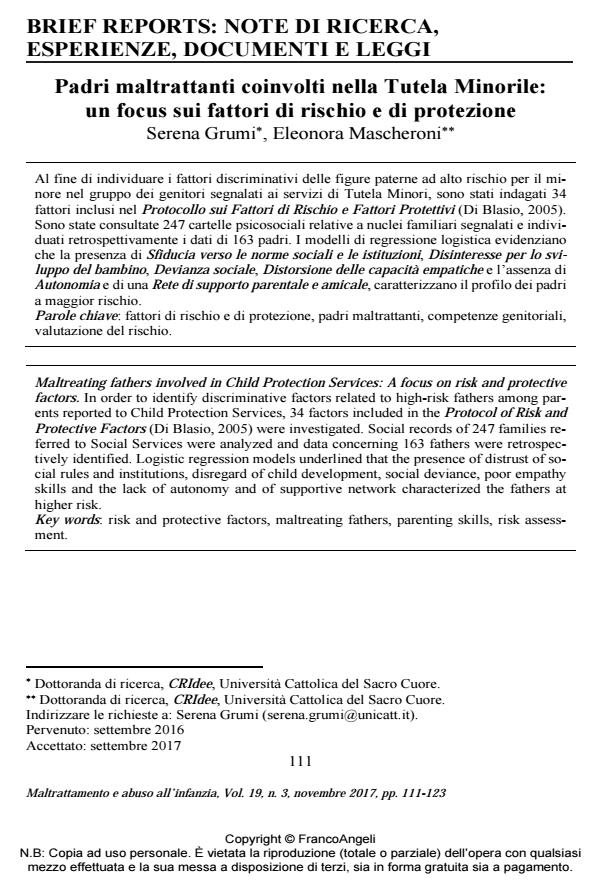Maltreating fathers involved in Child Protection Services: A focus on risk and protective factors
Journal title MALTRATTAMENTO E ABUSO ALL’INFANZIA
Author/s Serena Grumi, Eleonora Mascheroni
Publishing Year 2017 Issue 2017/3
Language Italian Pages 13 P. 111-123 File size 224 KB
DOI 10.3280/MAL2017-003007
DOI is like a bar code for intellectual property: to have more infomation
click here
Below, you can see the article first page
If you want to buy this article in PDF format, you can do it, following the instructions to buy download credits

FrancoAngeli is member of Publishers International Linking Association, Inc (PILA), a not-for-profit association which run the CrossRef service enabling links to and from online scholarly content.
In order to identify discriminative factors related to high-risk fathers among parents reported to Child Protection Services, 34 factors included in the Protocol of Risk and Protective Factors (Di Blasio, 2005) were investigated. Social records of 247 families referred to Social Services were analyzed and data concerning 163 fathers were retrospectively identified. Logistic regression models underlined that the presence of distrust of social rules and institutions, disregard of child development, social deviance, poor empathy skills and the lack of autonomy and of supportive network characterized the fathers at higher risk.
Keywords: Risk and protective factors, maltreating fathers, parenting skills, risk assessment.
- Familial risk and protective factors affecting CPS professionals’ child removal decision: A decision tree analysis study Luca Milani, Serena Grumi, Elena Camisasca, Sarah Miragoli, Daniela Traficante, Paola Di Blasio, in Children and Youth Services Review 104687/2020 pp.104687
DOI: 10.1016/j.childyouth.2019.104687 - La valutazione della recuperabilità delle competenze genitoriali Michela Gardon, in MALTRATTAMENTO E ABUSO ALL'INFANZIA 1/2022 pp.87
DOI: 10.3280/MAL2022-001006 - The CPS Workers’ Child Removal Decision in Cases of Domestic and Witnessed Violence Luca Milani, Serena Grumi, Elena Camisasca, Sarah Miragoli, Martina Cattani, Paola Di Blasio, in Journal of Interpersonal Violence /2023 pp.6819
DOI: 10.1177/08862605221137710
Serena Grumi, Eleonora Mascheroni, Padri maltrattanti coinvolti nella Tutela Minorile: un focus sui fattori di rischio e di protezione in "MALTRATTAMENTO E ABUSO ALL’INFANZIA" 3/2017, pp 111-123, DOI: 10.3280/MAL2017-003007